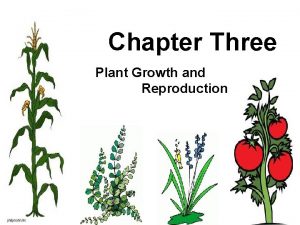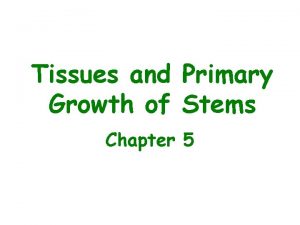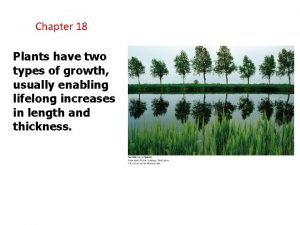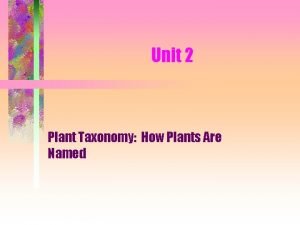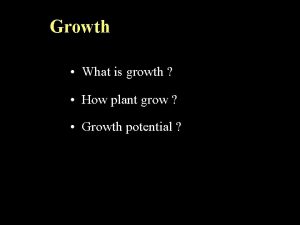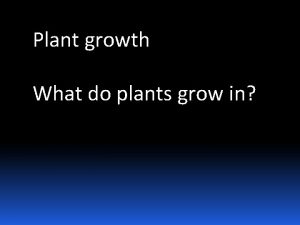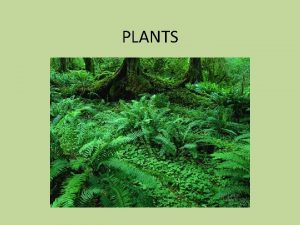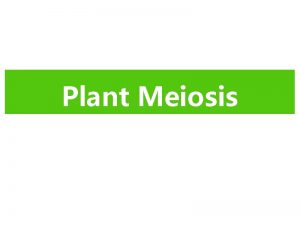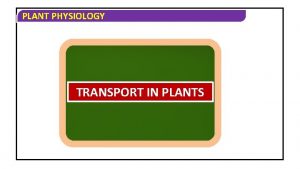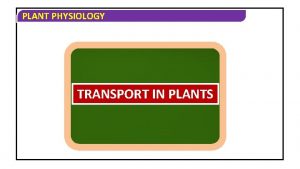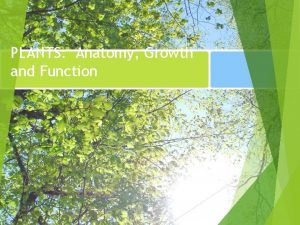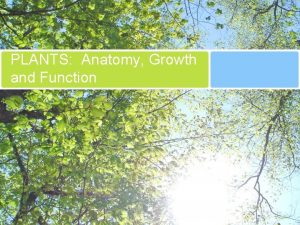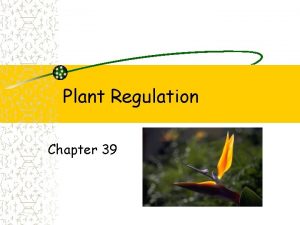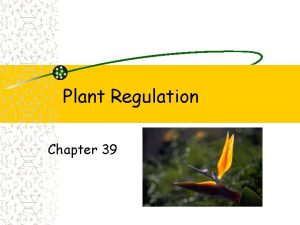Plant Growth So how do plants grow There


















- Slides: 18

Plant Growth So how do plants grow? There must be an area of growth, similar to how the bones in your fingers, arms, and legs grow longer. There is, and it is called the apical meristem, which is shown here. Growth of Plants Most plants continue to grow throughout their lives. Like other multicellular organisms, plants grow through a combination of cell growth and cell division. Cell growth increases cell size, while cell division (mitosis) increases the number of cells. As plant cells grow, they also become specialized into different cell types through cellular differentiation. Once cells differentiate, they can no longer divide. How do plants grow or replace damaged cells after that? The key to continued growth and repair of plant cells is meristem. Meristem is a type of plant tissue consisting of undifferentiated cells that can continue to divide and differentiate.

Apical meristems are found at the apex, or tip, of roots and buds, allowing roots and stems to grow in length and leaves and flowers to differentiate. Roots and stems grow in length because the meristem adds tissue “behind” it, constantly propelling itself further into the ground (for roots) or air (for stems). Often, the apical meristem of a single branch will become dominant, suppressing the growth of meristems on other branches and leading to the development of a single trunk. In grasses, meristems at the base of the leaf blades allow for regrowth after grazing by herbivores – or mowing by lawnmowers. Apical meristems differentiate into the three basic types of meristem tissue which correspond to the three types of tissue: protoderm produces new epidermis, ground meristem produces ground tissue, and procambium produces new xylem and phloem. These three types of meristem are considered primary meristem because they allow growth in length or height, which is known as primary growth. Microphotograph of the root tip of a broad bean show rapidly dividing apical meristem tissue just behind the root cap. Numerous cells in various stages of mitosis can be observed.

Secondary meristems allow growth in diameter (secondary growth) in woody plants. Herbaceous plants do not have secondary growth. The two types of secondary meristem are both named cambium, meaning “exchange” or “change”. Vascular cambium produces secondary xylem (toward the center of the stem or root) and phloem (toward the outside of the stem or root), adding growth to the diameter of the plant. This process produces wood, and builds the sturdy trunks of trees. Cork cambium lies between the epidermis and the phloem, and replaces the epidermis of roots and stems with bark, one layer of which is cork. Woody plants grow in two ways. Primary growth adds length or height, mediated by apical meristem tissue at the tips of roots and shoots – which is difficult to show clearly in crosssectional diagrams. Secondary growth adds to the diameter of a stem or root; vascular cambium adds xylem (inward) and phloem (outward), and cork cambium replaces epidermis with bark.



Collenchyma cells have primary walls that are usually thickened especially at corners or edges. They function for structural support. It is easy to see the cell wall thickening between each collenchyma cell in celery. The middle lamella is evident as an "X-shaped" mark between cells.

Compare the appearance of the thickened primary walls of collenchyma cells with the thickened secondary walls a fiber cell that contain lignin. Collenchyma cells and fibers both function to support the stem or leaf, but unlike fibers, collenchyma cells are usually living at maturity.

Parenchyma cells are the type of living plant cells, which are known for healing and repair mechanism, and food storage. Parenchyma is the most simple tissues made up of living cells and forming the thin layer called as primary cell wall of the plant. Parenchyma is taken from the Greek word “Parenchyma”, meaning ‘something poured in beside’. In plants, parenchyma cells are widely distributed all over and occur as continuous mass from the stems to roots, leaves, fruits. Parenchyma cells are responsible for generating many other specialised cells and tissues. Structurally they are isodiametric in shape as they have thin cell walls, due to which they face force and pressure around the walls of the cells and in this condition, the cell increases its volume capacity, in order to equalize the pressure all over the cells. The walls of the cells are mainly composed of the hemicellulose and cellulose. The parenchyma cells are abundant in organelles like ribosomes, Golgi bodies, Endoplasmic Reticulum, Chloroplast and other content like pigments, starch, fats, proteins. These contents provide the nutrients to the germinating embryo. Due to their cellular structure, parenchyma plays multiple roles in different parts of the plants. Some of the chief function of the parenchyma cells are storage, transporting, gas exchange, protection, photosynthesis, repairing the damaged tissues and in generating other specialised cells. Thus, parenchyma cells play a vital role in the overall development of the plant, throughout its life.

Sclerenchyma is said as the dead tissues of the plants because it comprises of the hardwood. The secondary walls of the matured sclerenchyma cells are densely thick and contain lignin and hemicellulose. These types of cells are hard, nongrowing and non-stretchable and are present in mature stems or bark. Sclerenchyma is found in many different sizes and shapes, but sclereids and fibres are of main types. Sclereids are found in tissues like xylem, phloem, pith, cortex and periderm. This cell also contributes to the hard covering of nuts and fruits and other seeds too. Fibres support the plants, as these are elongated cells present in bulk in every part of the plant. Some types of fibres such as leaf, seeds hairs are economically important also as they are used as woven and textile materials.

Key Differences Between Parenchyma, Collenchyma and Sclerenchyma Given below points will differentiate three types of ground tissues present in plants, which are parenchyma, collenchyma and sclerenchyma: 1. Parenchyma is one of the types of living plant cells originating from ground and protoderm meristem. These type of cells are most abundantly found in plants tissue. Another type of living plant cells originating from the pro-cambium, known as collenchyma cells. The epidermal layers of the plant are made of these cells. Thirdly the hard and outer part of the stem is made up of the sclerenchyma cells. These are the dead plant cells which originate from ground meristem and protoderm procambium. 2. Parenchyma cells are found in every soft part of the plant, but collenchyma cells are found in specific part of the plant like leaves, stems, and petioles, whereas sclerenchyma cells are found in mature parts of the plants or trees. 3. There are different types of shapes of all the cells, but generally, parenchyma cells are isodiametric, while collenchyma are elongated and sclerenchyma are sclereids, fibre in their shapes respectively. 4. Parenchyma has a thin cell wall of their cells, and are made up of cellulose. Whereas collenchyma cells have an uneven cell wall made up of pectin and hemicellulose. There is a hard and thick cell wall present of the sclerenchyma cells, which is made up of the lignin. 5. Intercellular space between the cells is present in parenchyma cells, while in collenchyma cells less space is present between the cells and in sclerenchyma cells, intercellular space is absent due to which cells are tightly packed. 6. The function of parenchyma cells is in the storage of foods, in gaseous exchange, and in photosynthesis, while collenchyma cells provide mechanical support and elasticity to the plant, the sclerenchyma cells provides mechanical support to the plant. It also supports transportation of water and nutrients to the plants.

https: //www 2. estrellamountain. edu/faculty/farabee/biobk/Bio Book. PLANTANAT. html







 Eudicot
Eudicot Primary growth and secondary growth in plants
Primary growth and secondary growth in plants Vascular ray
Vascular ray When you hear the word scientist what comes to mind
When you hear the word scientist what comes to mind What makes plants grow
What makes plants grow What makes plants grow
What makes plants grow What makes plants grow
What makes plants grow What non vascular plants
What non vascular plants Non vascular plant reproduction
Non vascular plant reproduction Characteristics of flowering and non flowering plants
Characteristics of flowering and non flowering plants C3 plant
C3 plant Walnut cross section
Walnut cross section Dermal tissue types
Dermal tissue types Relative growth rates
Relative growth rates Growthchain
Growthchain Geometric vs exponential growth
Geometric vs exponential growth Neoclassical growth theory vs. endogenous growth theory
Neoclassical growth theory vs. endogenous growth theory Organic growth vs inorganic growth
Organic growth vs inorganic growth Unit 2 plant taxonomy how plants are named
Unit 2 plant taxonomy how plants are named






